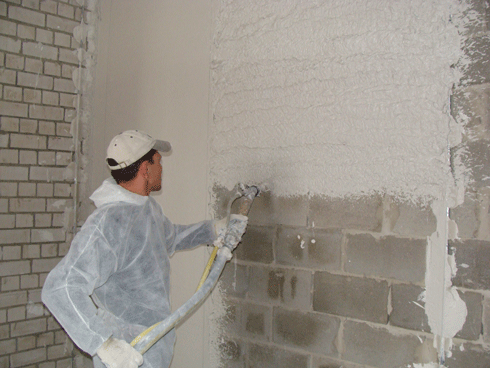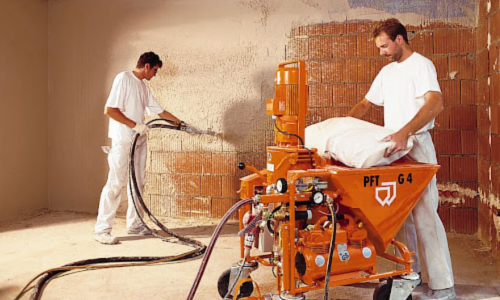The walls of the walls are one of the most responsible moments of the entire process of housing. It is these surfaces that occupy most of any room, and in addition are in constant visibility - directly at the level of the view in any position. The most popular solution of the draft and decorative finish is invariably remains the method of plastering, and today it is the mechanized method of application that all the features of which are presented in this article.
Content
Where do the mechanized plaster apply?
The plaster of the walls with a mechanized manner, in principle, does not have particular limitations in terms of the place of execution.
The main directions of application of this technology:
- facades of buildings;
- walls indoors;
- other overlaps.
Important! The mechanized plaster of the walls, the price of which depends entirely on the volume, finds the most favorable use for the finishing of large rooms, as in this case the optimal combination of material consumption, the use of expensive equipment and the volume of work performed is achieved.
Benefits of mechanical plaster
Permanent positive feedback on the mechanized plaster, fully confirm the full range of its advantages.
The most significant of them are determined by the following facts:
- performance of work mechanically is much cheaper due to the low value of the material;
- the material is saved, in contrast to shocking manually - almost 5 times;
- minor amount of waste;
- acceptable cost;
- the process of wall decoration takes less time due to the rapid drying of the thick layer of the plaster - it is possible to start further finish by 3-5 days;
- reduces the timing of the performance when finishing large areas almost 5 times, due to the speed of the equipment;
- minor labor costs;
- the ideal evenness and smoothness of the decorated coating, which eliminates the need for additional adjustment of irregularities;
- the finished mixture is fed under pressure, which contributes to the best adhesion of the particles of the solution with the base of the walls;
- the composition of the mixed has a high quality, which is achieved due to the control of the exact ratio. "Dry material-water";
- the durability and strength of such surfaces is much higher than after working manually;
- the price of construction mixtures for mechanical use is several times lower.
The cost of mechanized plaster walls
It is believed that the cost of mechanical plaster is very high. But if you really compare all expenses on manual and mechanized, it will eventually come true that mechanical is much cheaper. The cost of consumption of plaster is calculated by calculating the use of material by machine method by 1 m2. The volume of services includes plastered walls, priming and establishing beacons.
Important! Given the fact that the price of the mixture is cheaper, the solution consumption is less, it is necessary to perform a smaller number of people to fulfill all the work, the total volume value as a result gives savings of 20-30% compared to the manual method.
Sequence of performance
Conducting plaster works by mechanical way includes 3 consecutive stages:
- Preparation of the basis.
- Surface treatment.
- Technical pause for complete drying of the plaster mix.
Important! When the material is applied by the mechanical method, the drying of the surface occurs much faster due to the addition of special hardeners into the mixture, and the consistency of the sprayed solution is finely dispersive.
Preparation of plastering walls
For a good result of construction work on plastering walls, perform special surface preparation, adhering to the following recommendations:
- Clean the surface from the mounting glue, concrete influx, eliminate the protruding metal elements.

- Specify the surface processing with a special anti-corrosion solution.
- If you find cracked, close them using a mesh from Capron and putty.
- Perform an check on the flattening walls.
Important! Using the building layer, determine the clarity of the wall verticality, and with the template - horizontal.
- Check the location of the corners.
- Install lighthouses.

Features of the device and operation of equipment
Special equipment is a separate container into which the plaster dry mixture is falling asleep. Then, from the acceptance compartment, the material enters the mixing chamber and with the help of a mixing element - helix, thoroughly mixed with water until the formation of a homogeneous mass. Through a high-pressure hose, the solution is fed into the gun from which it is sprayed to the surface of the wall of a powerful jet. 
Technology of mechanized plaster walls
All technology of application is quite simple, if clearly adhering to the following recommendations:
1. Prepare a mixture directly next to the work site.
2. Fully pull your hands while holding the machine, and spray the solution at a distance of 20-30 cm from the surface.
Important! Ensure that the jet falls out strictly perpendicular to the surface being processed.
3. First of all, fill the angles, move from them further along the wall.
4. Plaster layers apply sequentially in a horizontal direction, half-covering the previous layer.
5. Adjust the thickness of the applied layer by moving the pistol.
6. After processing with a solution, perform a manual screed with an aluminum profile.
7. Distributed mixture for lighthouses, filling out the voids formed or removing excess.
8. An hour after the film begins to form on the surface, cut the stucco with a trapezoid profile.
9. Slide the surface with a special wide spatula after the solution has grip enough, but not fully hardened.
10. Further facing of the selected material, follow the complete frosting of plaster.
Mechanized wall plaster - video
Review the proposed video, which includes a visual example of the fulfillment of the entire plastering procedure with the use of mechanized equipment to make it yourself in the rationality of such a solution.
Conclusion
Mechanized wall plaster is an effective way of finishing the surface. By preferring such an option, you will certainly appreciate all the advantages of the building process and will be able to quickly complete all the repair work with minor costs, having received a qualitative result.





























